-
Paper Information
- Previous Paper
- Paper Submission
-
Journal Information
- About This Journal
- Editorial Board
- Current Issue
- Archive
- Author Guidelines
- Contact Us
International Journal of Hydraulic Engineering
p-ISSN: 2169-9771 e-ISSN: 2169-9801
2015; 4(1): 10-16
doi:10.5923/j.ijhe.20150401.02
Impact of Unfavorable Pressure Gradient and Vegetation Bed on Flow
Ali Keshavarz 1, Hossein Afzalimehr 1, Vijay P. Singh 2
1Department of water engineering, Isfahan University of Technology, Isfahan, Iran
2Dept. of Biological and Agricultural Engineering & Zachry Department of Civil Engineering, Texas A&M University, USA
Correspondence to: Hossein Afzalimehr , Department of water engineering, Isfahan University of Technology, Isfahan, Iran.
| Email: |  |
Copyright © 2015 Scientific & Academic Publishing. All Rights Reserved.
Vegetation in free streams plays an important role in environmental hydraulic studies. Experiments were conducted in a flume with plexiglas walls and vegetated bed in the hydraulics lab with different flow discharges and flow depths. Results showed that the main velocity and main turbulence intensity as well as the Reynolds stress distributions were affected by the presence of vegetation in the channel but not by the variation of flow depth and discharge. The log law in the inner layer and the velocity defect law in the outer layer held reasonably over the vegetated bed under unfavorable (adverse) pressure gradient.
Keywords: Unfavorable pressure gradient, Turbulence intensity, Reynolds stress, Vegetation bed, Flume
Cite this paper: Ali Keshavarz , Hossein Afzalimehr , Vijay P. Singh , Impact of Unfavorable Pressure Gradient and Vegetation Bed on Flow, International Journal of Hydraulic Engineering, Vol. 4 No. 1, 2015, pp. 10-16. doi: 10.5923/j.ijhe.20150401.02.
Article Outline
1. Introduction
- Vegetation in natural channels and river flood plains influences the flow field and related phenomena, like erosion and sedimentation, nutrients, pollutant and metal transport, wave energy dissipation, and life of microorganisms ([1-7]).The study of flow and turbulence characteristics in vegetated open channels has been of great interest over the past couple of decades. For studying the flow above and within the vegetation both experimental and numerical approaches have been used [8].Vegetation is flexible in varying degrees, and it oscillates in the flow, changing position. In vegetated channels, flow depth and the nature of vegetation as hydraulic roughness may vary widely. The depth of flow may be such that it is less than or equal to (large-scale roughness), or greater than (small-scale roughness) vegetation height. Flow in a vegetated channel is essentially a movable boundary problem, since roughness elements are deformed by the flow within the channel [9]. Two types of vegetation are usually defined: stiff and flexible. Flexible herbaceous vegetation is widely used as a protective liner in agricultural waterways, flood channels and emergency spillways [10].According to Gourley (1970) there are three layers in the experimental velocity profiles in a vegetated bed channel: (1) a layer of virtually constant low velocity within the grass near the bed in which the velocity can be assumed proportional to the shear velocity; (2) a layer of rapidly increasing velocity within the upper part of the vegetation elements; (3) a layer of less rapidly increasing velocity above the grass [11]. Kouwen et al. (1969) distinguished a logarithm velocity profile over artificial flexible vegetation (strips of styrene) [12].Based on experimental studies of Carollo et al. (2002) all the measured velocity distributions were S-shaped, as observed by previous studies on flow in vegetated channels. For each experimental profile three zones were identified: zone Ι inside the vegetation, characterized by very small velocities; zone ΙΙ in which the logarithm velocity can be fitted to the measured velocities (logarithm zone); and zone ΙΙΙ characterized by positive vertical velocity gradients, progressively decreasing to zero near the free surface where the velocity profile becomes vertical (free stream zone) [9]. In addition to affecting the mean velocity, vegetation also affects the turbulence intensity and the Reynolds stress [13]. Jarvela (2005) showed that the flow structure above the submerged young wheat was comparable to that found in the studies involving flexible vegetation. The flow above the wheat reasonably followed the log law and maximum values of urms and -u'w' were found approximately at deflected plant height. The velocity profile showed an inflection point which superposes with the maximum turbulence and it occurs above the vegetation cover [10]. Also the Reynolds stress distribution revealed its maximum value above the upper limit of the vegetation cover [14].In previous works over vegetated beds, researchers have not considered the non-uniformity of flow. In nature, due to the topography of bed, most of the time, the flow is not uniform, therefore the study of non-uniformity of flow over vegetated beds is essential to understand the hydraulic parameters distributions. In this study, the case of unfavorable pressure gradient (decelerating flow) over the vegetated bed in a laboratory flume is investigated. The aim of the study is to determine how the interaction of vegetation bed and pressure gradient affects the main flow velocity, turbulence and Reynolds stress distributions. Also, the validity of the log law in the inner layer and Coles method in the outer layer are investigated.
2. Experimental Setup and Measurements
- Experiments were conducted in a 8-m long, 0.4-m wide and 0.6-m deep flume with plexiglas walls in the hydraulics laboratory of Isfahan University of Technology, Iran. To produce a decelerating flow where the pressure gradient is adverse, gravel with different heights from the flume bed were deposited in the flume. Then, grass seeds, which were cultivated in metal boxes 0.4-m long, 0.2-m wide and 0.05-m deep, were transferred to the laboratory and were placed over the gravel in the flume. The entire length of the flume bed was covered with grass. We tried to keep the height of the grass constant (about 8-cm) during measurements. The density of the grass was 27000 stems per square meter.A movable downstream weir was used to change the depth of flow. An upstream storage reservoir was used to reduce the flow entrance turbulence. Our experiments were conducted in four runs with two different depths of flow (0.15m and 0.2 m at section 6-m from the entrance of the flume) and two different flow discharges (5.7 l/s and 7.2 l/s). The slope of the flume bed was set as 2%. The slope of the bed was formed by using gravel along the flume.Velocity measurements were performed by using an Acoustic Doppler Velocimeter (ADV). The ADV is a 200-Hz Nortek Vectrino. To remove possible aliasing effects, the velocity time series were analyzed using WinADV [15], which is a windows based viewing and post-processing utility for ADV files. This software provides signal quality information in the form of a correlation coefficient (COR) and signal to noise ratio (SNR). Almost 75% data were considered suitable using WinADV criteria Correlation coefficient >90% and signal to noise ratio (SNR) >20. The data of the poor quality were removed from this study and were not replaced. At each point, the flow velocity was sampled with a frequency of 200-Hz and 120 seconds (our last experiences revealed that this duration for sampling is adequate for determining accurate turbulence statistics).
 | Figure 1. Schematic picture of experimental setup |
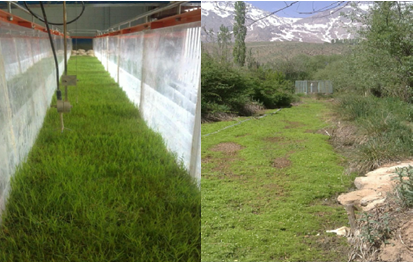 | Figure 2. Comparison between the experimental setup and a natural channel |
3. Experimental Results and Discussion
3.1. Velocity Distribution
- Based on velocity profiles in Fig.3, three regions can be distinguished: (1) the region where the flow is at the top of canopy; in this region ADV is able to collect data. In this region, however, the values of velocity have low gradient; (2) the region where an inflection point exists, showing the contribution of unfavorable pressure gradient in the flow velocity distribution. In this region the velocity gradient and the shear stress are considerable; and (3) the region near the water surface where velocity profile tends to approach a vertical lineshowing low shear stress and the maximum flow velocity.
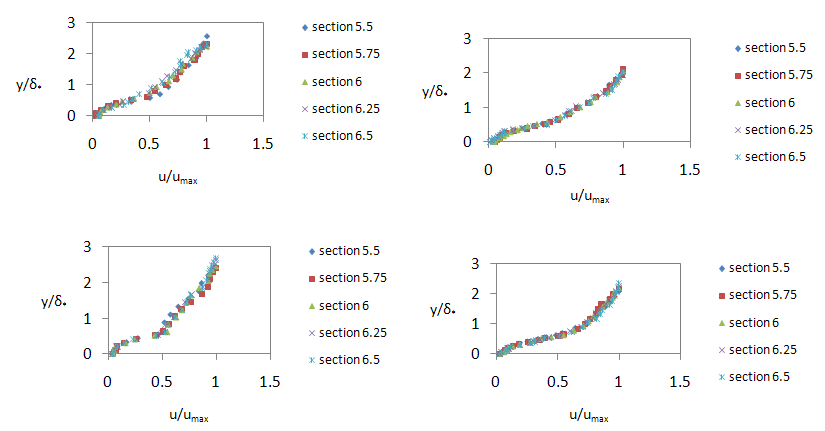 | Figure 3. Measured velocity profiles for all test series |
 | (1) |
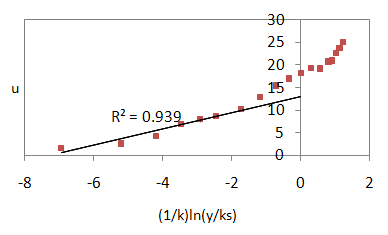 | Figure 4. Logarithm law validity in the inner layer |
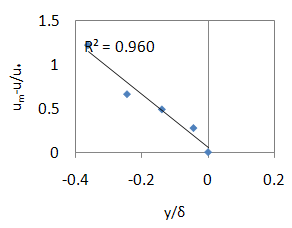 | Figure 5. Defect velocity validity in the outer layer |
|
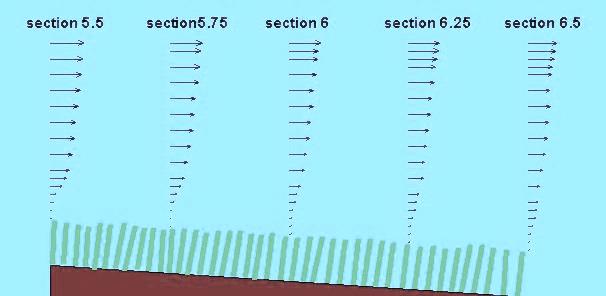 | Figure 6. Change of velocity profiles along the flume |
 | (2) |
 | (3) |
 | (4) |
3.2. Reynolds Stress and Turbulence Intensity
- In turbulent flows, due to rapid fluctuations of velocity components, there is momentum transfer between the layers of flow. The main factors that have to be taken into account in turbulent flow studies are Reynolds stress and turbulence intensity. The main component of Reynolds stress τxy is represented by:
 | (5) |
 | (6) |
 | Figure 7. Reynolds stresses for test series 1 |
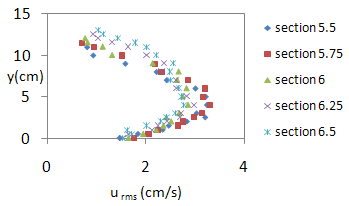 | Figure 8. Root mean square distribution of u' |
 | Figure 9. Reynolds stress and velocity distributions |
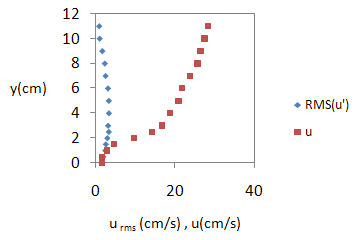 | Figure 10. Turbulence intensity and velocity distributions |
4. Conclusions
- The flow characteristics above submerged grass were studied under unfavorable pressure gradient. The flow velocity displays a clear inflection point due to vegetation. Such inflection point is not observed in gravel bed streams under unfavorable pressure gradient. The log law is valid above the vegetation cover in the inner layer and the defect velocity law fits reasonably well the outer layer data.The dimensionless pressure gradient parameter (β) follows Graf’s criterion (1998) for flow non-uniformity over the vegetated bed. The Reynolds stress and turbulence intensity distributions display a convex form which has been observed over gravel-bed streams.
Notation
- u = Mean point velocityu* = Shear velocityx = Longitudinal coordinatey = Vertical coordinateuave = Average velocity at a sectionumax = Maximum velocity U∞ = Surface water velocityκ = von Karman constantKs = Roughness scaleC=constant of log lawδ = Boundary layer thicknessb/h = Aspect ratioFr = Froud numberδ* = Displacement thickness of boundary layerθ = Momentum thickness of boundary layerβ = Pressure gradient parameterp = Pressureτ = Shear stressh = Water depth above the vegetationτxy = Reynolds stressu' = Turbulence intensity in the longitudinal directionv' = Turbulence intensity in the vertical directionρ = densityurms = Root mean square of u'
 Abstract
Abstract Reference
Reference Full-Text PDF
Full-Text PDF Full-text HTML
Full-text HTML